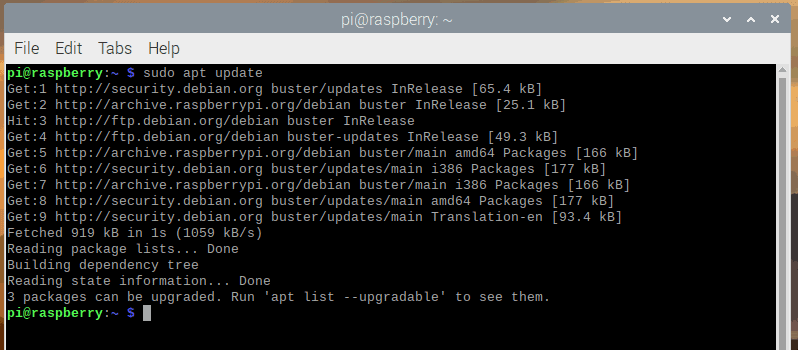
- #RASPBERRY PI SUDO APT GET UPDATE ALL HOW TO#
- #RASPBERRY PI SUDO APT GET UPDATE ALL UPDATE#
- #RASPBERRY PI SUDO APT GET UPDATE ALL UPGRADE#
If anything is broken after the installation, you’ll still have a way to easily come back to the current state of your system. But I also have an alternative to upgrading without commands if you are averse to it :).īefore going further, creating a backup of your SD card might be a good idea.
#RASPBERRY PI SUDO APT GET UPDATE ALL UPGRADE#
The easiest way to upgrade your system to a new version is to change the repositories used by APT. APT checks for new updates available on the repositories and suggests installation.
#RASPBERRY PI SUDO APT GET UPDATE ALL UPDATE#
Updating sources.listĪs mentioned in the introduction, we use APT to update all of the packages on the system (either directly or with a graphical tool intermediate). That’s why you can now update to test it (I don’t recommend it in production, or with essential services however). Raspberry Pi OS Bookworm is not yet considered stable, but the release date is coming soon and repositories for Raspberry Pi OS are already up and running. If you are using an old version, it’s a good idea to update it. For example, Raspberry Pi 4 doesn’t boot on Stretch and Raspberry Pi 3B+ doesn’t work on Jessie.ĭuring writing, the current stable version is Raspberry Pi OS Bullseye. If you have a recent Raspberry Pi model, you also have to use a recent Raspberry Pi OS version. You can check this guide to determine which version you currently have, and this introduction article to Raspberry Pi OS if you are not yet confident with it. Yes, all of the code names are based on Toy Story characters :). Raspberry Pi OS versionsīefore going further, you need to know which version you are currently using, and the new versions available.Īs previously mentioned, Raspberry Pi OS is based on Debian and follows the same versions:

The first third of the book teaches you the basics, but the following chapters include projects you can try on your own. It’s a 30-day challenge where you learn one new thing every day until you become a Raspberry Pi expert. If you’re looking to quickly progress on Raspberry Pi, you can check out my e-book here.
#RASPBERRY PI SUDO APT GET UPDATE ALL HOW TO#
In this tutorial, I’ll show you how to upgrade your system by editing the file and installing all of the new packages. You can use repositories to upgrade your software to the latest versions without losing any data. Raspberry Pi OS uses package repositories to download new updates and upgrade the software to the latest version.

If you’re behind and need to update your Raspberry Pi OS or want to try the next version (“Bookworm” e.g. The latest Raspberry Pi OS version available for download is currently “Bullseye”, based on Debian 10.

Raspberry Pi OS is based on Debian and follows its versions. Keep in mind that the Raspberry Pi Foundation recommends installing Bullseye from scratch, instead of upgrading it as explained in this tutorial. Note: This guide has been updated in November 2021, to explain how to upgrade RPI OS Bullseye to Bookworm, but you can use the same tips to upgrade Buster to Bullseye, which is now officially the stable version.


 0 kommentar(er)
0 kommentar(er)
